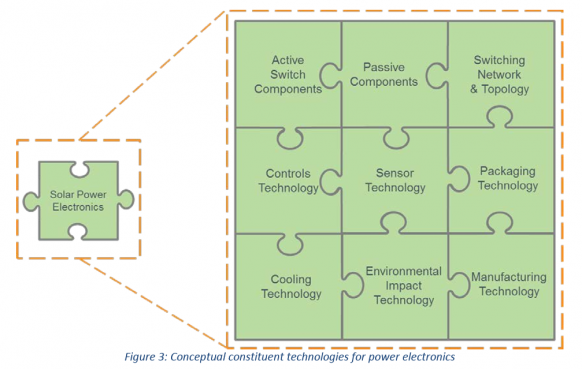Solar inverter research points to new income from grid services
Advanced inverter designs and modular power electronics can place PV plants at the heart of U.S. grid modernisation plans, Charlie Gay, Director of the Department of Energy's Solar Energy Technologies Office, told New Energy Update.

Related Articles
As falling costs continue to improve the business case for subsidy-free solar and wind projects, the U.S. government has launched a range of initiatives to enhance the resilience and reliability of the electricity grid.
Energy Secretary Rick Perry has highlighted the need for technologies and market mechanisms which enhance grid reliability and the DOE recently launched several research projects aimed at supporting a more diverse generation mix and the integration of smart devices and energy management measures.
The DOE's Solar Energy office launched September 12 a new round of R&D funding for power electronics programs which pursue cost reduction goals and address what the DOE called the "critical challenges" of grid reliability, resilience, and storage. The DOE's SunShot initiative has set a target of cutting the cost of utility scale solar power by 50% to $30 per MWh by 2030, and the new research funding aims to improve inverter performance and expand the capabilities of solar plants.
Utility-scale solar plants are well-equipped to provide fast communications services which could help grid operators manage the challenges posed by new devices such as home energy management systems, Gay told New Energy update.
"The natural interface for that is the power electronics that is integrated in with the output of the PV array," he said.
‘Holistic’ inverters
The DOE plans to award funding to between 10 and 15 power electronics research programs, for a total of $20 million. Performance would be assessed for up to 3 years and the projects will have a 20% cost share requirement. The funding program invites developers to set out the metrics they would use to demonstrate greater reliability, grid resilience, or lower costs.
US utility-scale PV inverter costs, efficiencies
(One-axis tracker)

Chart source: New Energy Update
Data source: NREL report: 'U.S. Solar Photovoltaic System Cost Benchmark: Q1 2017.' (September 2017)
A key area of the research will be 'holistic' solar PV inverter designs that reduce system costs while increasing efficiency and reliability.
"It's important that not only each component in the value chain have lower costs and higher efficiency, but that the pieces in the value chain can work together efficiently," Gay said.
The DOE believes recent advancements in semiconductors, power density, innovative controls and packaging solutions could cut inverter costs and improve reliability and it welcomes proposals across all types of inverters.
Developers must take into account upstream technicalities of the inverter interface with the solar array, as well as the downstream connection of inverter output to the transformer or substation, Gay said.
Constituent technologies for power electronics
(Click image to enlarge)
Source: DoE's Funding Opportunity Announcement: "Advanced power electronics designs for solar applications." (2017)
Modular designs
The DOE also wants to accelerate the development of modular power electronics designs which enhance functionalities such as integration of energy end user devices, grid services and online operations and maintenance (O&M) services.
Enhancements in the operational functionality of inverters could integrate new communication capabilities, Gay said.
"This communications capability could be used to offer a grid operator control of voltage and frequency parameters. That information might also feed back to a power plant operator who can see in real time the status and performance of each of the inverters," he said.
Other research areas identified by DOE include inverters integrated with energy storage power electronics, or inverters with enhanced protection functionality.
Modular enhancements and improved communications could also help to boost plant revenues.
"If a component within the package sends a signal that it is not working properly you could remotely swap out a different element of the circuit to maintain continuous operations," Gay said.
"Or an innovative design might incorporate a subassembly which can be easily swapped in the event of default," he said.
The DOE hopes to attract the most innovative power electronics solutions from across a range of industrial sectors, such as automotive and aerospace industries.
The development of power electronics in electric vehicles is a "large moving landscape" and companies could use solar sector applications to scale up their technologies, Gay noted.
Research pays
As the U.S. continues to see new types of power generation integrated into the power grid, increased communication capabilities should open up new business models for developers, Gay said.
"There are new innovations coming into play for the creation of power projects and the ability exists to be able to monetise the value of energy supplied to the grid," he said.
A grid reliability report published by the DOE in August recommended the implementation of pricing mechanisms which value Essential Reliability Services (ERS) and Bulk Power System (BPS) resilience. The DOE would research new technology which helps renewable energy plants provide ERS and support BPS resilience, it said.
Some grid operators have already implemented new financial models to take into account the use of automated metering and power management units.
Going forward, the widening array of power generation sources and off grid applications will require more advanced grid balancing systems and valuation measures, Gay said.
"The time value of electrons and location value of electrons enhances an increasingly sophisticated set of market opportunities," he said.
New Energy Update

